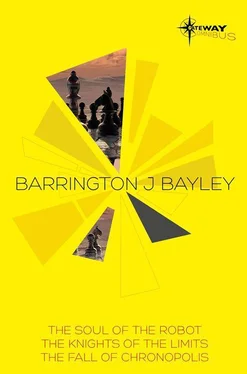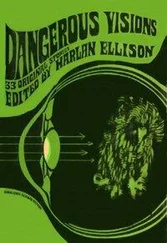‘Quite so. Have you ever seen the strat with your naked eyes, Colonel?’
Anamander was startled. ‘No, sir!’
‘I did once – just a glimpse. Not enough to derange the senses – just the briefest glimpse. It was years ago. I was on the bridge when our main engine cut out for a moment after – well, never mind about all that. But there it is: I saw it, or almost saw it. Yet to this day I couldn’t tell either you or myself exactly what it was I saw.’
‘I’ve heard it leaves a mark on a man.’
‘Yes, Colonel, it does. Don’t ask me what sort of mark.’
Haight sniffed the air, then shivered slightly. The rain was falling faster.
‘Let’s get inside. We’ll be drenched here.’
They crossed the turf and disappeared into the towering flagship. Half an hour later the whole fleet disappeared with a hollow boom that echoed around the empty plain. Shortly there came a crash of thunder and tumultuous rain soaked the savanna, pouring over the body of the courier who had died six centuries from home.
Colonel Anamander felt reassured with the thrum of the time-drive under his feet. They were building up speed, heading back into the past and traversing the planet’s time-axis to bring them to the right location in both space and time: the continent of Amerik, Node 5.
As it moved, the fleet sprayed beta rays all around it into the temporal substratum – the strat, as chronmen called it. Electromagnetic energy could not travel through the strat, rendering communication difficult. The answer for short-range purposes was beta radiation, consisting of relativistic electrons moving slower than light. They did not penetrate far, but they sufficed for the timeships to keep contact with one another while in formation, as well as to maintain a limited radar watch.
Haight’s orders were explicit. The hunt was on for the war craft that had violated the Imperial Millennium.
The enemy foray was well planned, as was evidenced by the failure of the Third Time Fleet to learn of it until the attackers had already passed to its rear. They had come in from the future at high speed, too fast for defensive time-blocks to be set up, and had only been detected by ground-based stations deep in historical territory. If the target was to alter past events – the usual strategy in a time-war – then the empire’s chroncontinuity could be significantly interfered with.
It looked to Haight as if the assault could signal the beginning of the full-scale war with the Hegemony which the High Command believed to be inevitable. The Hegemony, existing futureward of the Age of Desolation, had long been the chief threat to the Chronotic Empire, and it was almost certain that the raiders had been dispatched from that quarter.
If their intention was to test out the empire’s ability to defend itself, then Haight promised himself forcefully that they would be disappointed in the result. Like all chronmen he was fanatical in regard to his duty; service to the empire was the chronman’s creed. He felt personally affronted, not only by the intrusion into imperial territory, but also by the attempt to alter the relationship of the past to the future, a right that belonged to no one but their Chronotic Majesties the Imperial Family of the House of Ixian.
Commander Haight mulled the matter over while keeping one eye on the scan screens. The bridge, as it was called by convention, was a large, elongated hemi-ellipsoid. The controllers sat elbow to elbow along its curved walls, the pilot section being situated in the nose of the ellipsoid whereas another line of manned consoles ran along its middle axis. At the moment, the size-contraction effect caused by the flagship’s velocity through the strat was not pronounced enough to be noticeably dramatic. At top speed it would become so intense at the forward end of the ship that the pilots in the nose would be reduced to a height of inches, whereas the men in the rear would retain their normal size – an effect that gave the bridge a false impression of being drastically foreshortened.
The bridge crew numbered thirty-two men in all, not counting the cowled priest who moved among them dispensing pre-battle blessings and sprinkling holy wine. Commander Haight looked over the scene from the raised desk he shared with Colonel Anamander at the rear of the bridge. It had often amused Haight to think that, with the flagship undergoing full-speed test trials, a pilot who happened to glance back saw his commander as a massive titan hovering over him like an avenging angel.
A gong sounded. A scanman called out to him.
‘We have a track, sir!’
‘Follow it,’ rumbled Haight.
There was a slight sense of nausea as the flagship, the whole fleet following suit, shifted direction in the multidimensional strat. It was succeeded by a series of sensations felt only in the gut, as if one were trapped in a system of high-speed elevators. Travelling through the strat was sometimes like riding a crazy, oscillating switchback. Geodesic eddies and undulations, which time-travelling vehicles were obliged to follow, were apt to occur in it.
Haight and Anamander both watched the big monitor screen. The representation of the strat it was bringing them was roiling and curling as they rode through the disturbed region. (Haight knew that such a region often spelled danger for imperial stability: it could mean that an established sequence in orthogonal time was undergoing mutation.) Then, slowly, it smoothed out and the sick feelings no longer assailed their guts.
A blurred formation of foreign timeships hove into view.
There were three of them on the screen, held unsteadily by the scattered light of beta radiation. They were recognisably ships of the Hegemony: inelegantly tall, wedge-shaped structures travelling edge-on.
The images flickered and then yawed, swinging around and changing shape like a moving display of geometric variations. The scope was picking up four-dimensional images of the ships as they altered direction.
‘Projected destination?’ barked Haight.
A voice answered him. ‘Prior to course change, heading towards Node Seven, bearing seven-o-three on vertical axis.’
‘Fire torps.’
Down below, gunnery released a standard set of five torpedoes, and they saw them flickering away on the screen. There was little hope of any of them making a strike. Strat torpedoes were heavy, clumsy weapons whose light-duty time-drives gave them little speed and little range.
‘Shall we offer battle, sir?’ Anamander asked in a low voice.
Haight pondered briefly and shook his head. ‘They are on a homeward flight path after having completed their work. We need to find them on the ingoing flight before they’ve reached their target.’
The torpedoes faded away, lost in the strat. The Hegemonic warships eventually receded from view.
Haight gave the order to proceed pastward, traversing across the vertical time-axis. A hundred and fifty years deeper into historic territory he ordered the fleet to stand by; the flagship phased briefly into orthogonal time.
They hovered over a sunlit landscape. Down below, roads and rivers made a meandering pattern among the towns and villages that were dotted here and there across the patchwork of fields. The flagship’s computer library was busy comparing the scene with the official encyclopaedia, but neither Haight nor Anamander needed its report to know the worst. The geography of the place simply did not correspond to the official record. In particular, the sizeable city of Gerread was completely absent.
In orthogonal time the Hegemonic attack had already been successful.
Haight inspected the landscape carefully, looking for signs of recent devastation. There was none: it did not seem that Gerread had been removed by bomb or plague.
Читать дальше












